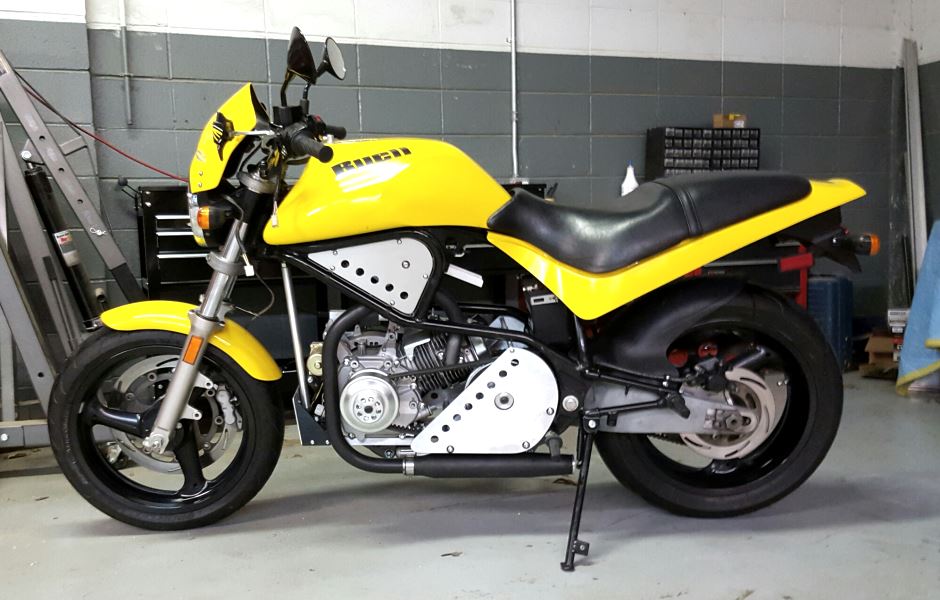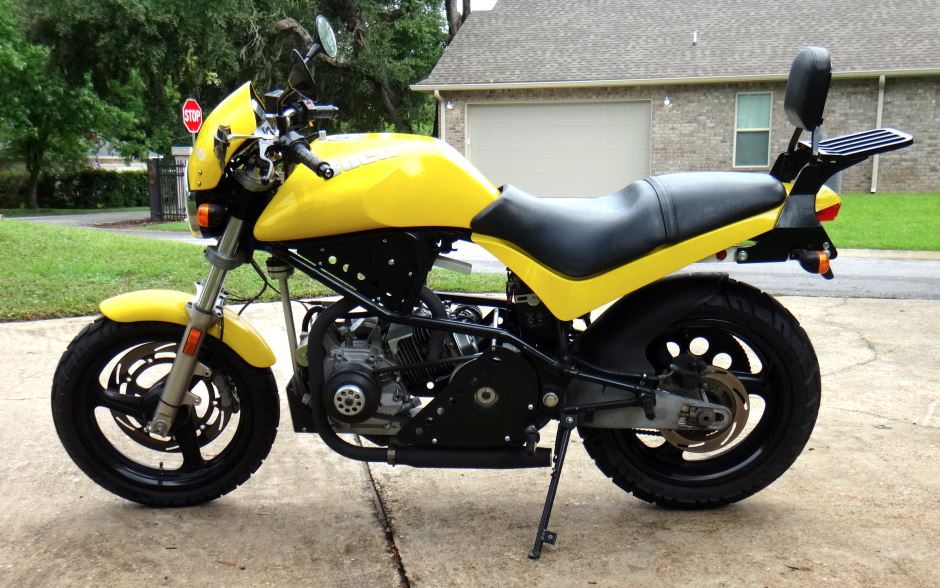


Back before Harley bought Buell Motorcycles, Eric Buell made light-weight, tube-framed cycles with modified 1200cc Harley Sportster motors. Fast, well-balanced, great brakes, and quite delicate.
I loved my Cyclone, but one day when I was looking at the frame design, It dawned on me that the Buell would make a great platform for testing small air-cooled industrial motors and CVT automatic belt transmissions. The following is my journey, and my conclusions.
First step was to get all of the extra stuff off so I could see the engine and frame clearly. That is an impressive packaging job that Eric Buell designed!

Now just the frame.

The front little triangulated structure under the main frame was there to support side-to-side motion of the Harley motor. It was not needed for the smaller motor so it was removed.

An "L" shaped, gusseted structure was fabricated from 6061-T6 aluminum and was attached to the same mounting points that the Harley motor used.
The motor that was selected was a 420cc Lifan (Honda clone). It has ball bearings on the crank, a steel cylinder sleeve, electric start, and an 18 amp charging circuit.
The jackshaft was located using standard pillow-block ball bearing.

The stock Buell rear shock was put back in its original position under the motor. The front of the shock attached to a steel weldment that bolted through the bottom aluminum plate.
A washable free-breathing air filter was added, some 1/8" aluminum plates we attached on both sides to close off belt and chain areas, and a debris guard was added at the front of the base plate.

A custom exhaust was fabricated which put the muffler back in the factory stock location.
A Comet model 40 CVT driver and driven transmission were added. I choose the Comet because it is the standard for medium-sized CVTs. There are also tons of clones, and parts are easy to find.

Later on, I also tested the Comet model 44 driver. It was a direct drop-in replacement for the Comet model 40, and the rear driven unit and belt did not need to be changed.

The only thing on the modified Buell that required a learning curve was the CVTs. They worked OK, but there were things to learn before they worked really well.
The main issue with the model 40 driver was with the weights. They tended to stick in the engaged position which would stall the motor when the bike came to a stop. I ended up needing to lub the weight tracks about every 300 miles. I tried spray-on drylub and anti-sieze grease. I found the anti-sieze to last longer and as long as you did not put on too much, it did not sling out of the clutch. One of the springs in the model 40 also broke after about 2000 miles.
The model 44 is my favorite. It is a completely different design than the model 40. I have not needed to do any maintenance in over 3000 miles. The high-end of the ratio change is also a little better on the model 44 so the top end speed is a bit higher.
I set up the motorshaft-to-jackshaft dimension exactly per specs at first. With both clutches, it seemed like the belt did not go tight until the belt was about halfway between its lowest position and its highest position on the driver. It appeared I was loosing some of the lower gear part of the clutch. I was also having trouble with belt squeek during takeoff.
I pulled the base aluminum plate and machined it so the motormount holes became 1/2" motormount slots. Wow, what a difference! I moved the motor forward a bit so the belt engaged sooner. Belt squeek went away, takeoffs were quicker, and top end increased.
I have put a total of about 5500 miles on the modified Buell. It will easily keep up with traffic when accelerating from a stoplight, cruises at 60 MPH at 3500 RPM, and gets about 60 MPG.
These industrial motors do not like to run above 3600 RPM unless modified. Luckily, there are lots of after-market parts for these motors since they are used in go-karting. I have read that 30+ HP is possible with this motor. I am happy with it in its stock configuration.
I started out with the clutch and sideplates silver. Later, changed them to satin-black. I have never decided which color scheme I like better.


This has been a very interesting project for me. I hope you have enjoyed looking it over too.
Best regards,
Dave
|





